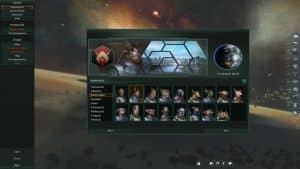Stellaris
Related apps
Description
🔥 What is Stellaris?
Stellaris is a grand strategy and space exploration game developed by Paradox Interactive, available for PC. Known for its expansive universe and dynamic gameplay, Stellaris blends 4X (explore, expand, exploit, exterminate) strategy with deep role-playing elements. Since its release in 2016, it has consistently evolved through updates and DLCs, building a passionate community of spacefaring strategists and offering one of the most versatile strategy experiences available.
In Stellaris, players command an interstellar civilization, guiding its development from the dawn of space travel to the rise of a powerful galactic empire. You can choose from a wide array of pre-made species or craft your own, customizing physical traits, cultural ethics, government types, and even the origin story of your people. With procedurally generated galaxies, branching event chains, and emergent storytelling, no two playthroughs are the same, giving the game a level of replayability that few other titles can match.
Stellaris also embraces science fiction in its purest form, allowing players to confront alien species, build colossal megastructures, and face existential threats like sentient machines or dimensional invaders. Whether you’re a peace-loving xenophile or a ruthless exterminator, the galaxy is yours to shape.
👉 Features of Stellaris
Extensive Customization
Stellaris gives players unprecedented control over their empires. Customize your species’ appearance, societal traits, ethical foundations, and civics, which influence everything from diplomacy to military doctrine. This customization extends to ship design, fleet compositions, and even planet management policies. You can determine what technologies to pursue, how to govern your citizens, and how to deal with outsiders — be it through trade or war.
Procedurally Generated Galaxies
Each game takes place in a procedurally generated galaxy filled with hundreds of star systems, planetary bodies, anomalies, and unexpected events. This ensures that every playthrough is a new experience, with new neighbors, threats, and opportunities. Some galaxies may be teeming with life, while others are filled with ancient ruins or hostile empires.
Complex Diplomacy and Politics
Diplomacy in Stellaris is rich and nuanced. Interactions with other empires can include trade deals, research agreements, rivalries, and alliances. Players can form federations and compete in the Galactic Community, where policies are voted on that can reshape the entire galaxy. Espionage and covert operations add a layer of intrigue, allowing you to manipulate or destabilize rivals from within.
Science and Technology Trees
Scientific progress is essential to your empire’s advancement. The research system is semi-randomized, meaning players must adapt their strategies to the cards they are dealt. As your technology develops, you can unlock new starship classes, better infrastructure, advanced AI, and even galactic wonders like Dyson spheres or ringworlds. Special research paths also include psionics, synthetics, and biological ascension.
Story-Driven Events and Anomalies
Exploration leads to story-rich events, many of which are triggered by surveying anomalies or colonizing planets. These events often come with narrative choices that can have long-lasting consequences. From discovering ancient AI to unleashing a hive-mind plague, the universe is filled with mysteries and opportunities for dramatic storytelling.
Expansions and Modding Community
Stellaris is supported by an active development team and a vast modding community. Official expansions like Utopia, Apocalypse, Nemesis, and Overlord introduce new mechanics such as internal politics, espionage, and vassal empires. On the modding side, players have created total conversions, new species, and expanded mechanics, adding near-infinite ways to play the game.
Gameplay
Empire Management
The heart of Stellaris is empire management. This includes planetary development, resource allocation, population control, and administrative efficiency. As your empire expands, so does the complexity of managing it. You’ll need to maintain stability, balance economic output, and integrate new planets — some of which may be home to conquered or integrated alien populations.
Managing planets involves zoning them for housing, industry, science, and unity production. Each planet also has its own infrastructure needs and can be further customized with unique buildings and governor assignments. Empire cohesion, corruption, and sprawl become more pressing as you extend your reach.
Warfare and Fleet Tactics
While diplomacy is an option, sometimes war is inevitable. Stellaris offers real-time-with-pause combat where players can design and build customized fleets suited to different threats. Battle outcomes depend on fleet composition, tech level, admiral traits, and strategic positioning. War goals and casus belli determine the objectives, whether it’s territorial gain, liberation, or ideological enforcement.
Naval capacity and strategic resources must be carefully managed to maintain effective defenses and offensive readiness. Space stations, planetary defense grids, and juggernauts (massive command ships) allow for dynamic defense strategies.
Exploration and Colonization
Early-game exploration is key to long-term success. Science ships explore new systems, find habitable worlds, and uncover anomalies that lead to special technologies or events. Colonization involves settling new planets, which then require development and integration into your empire. Some worlds may be rich in resources but hostile to your species’ biology, requiring gene-editing or terraforming.
Frontier expansion brings its own risks, such as provoking neighboring empires, encountering ancient guardian civilizations, or triggering dormant threats. However, bold expansion is often necessary for resource acquisition and strategic positioning.
Internal Politics and Governance
Empire ethics and civics shape internal governance. Your people may demand reforms, resist authoritarian policies, or rise in factional movements that must be appeased or suppressed. Leaders from governors to scientists and admirals gain experience and traits that impact their roles, adding a role-playing element to strategic decisions.
Government types from democratic to imperial affect how laws are passed and how succession is managed. Unity points can be used to adopt traditions that unlock powerful ascension perks, allowing players to genetically modify their species, embrace synthetic immortality, or unlock psionic powers.
Endgame Crises
Once you’ve dominated much of the galaxy, new threats emerge to keep the game exciting. These “endgame crises” can include interdimensional invaders, rogue AI rebellions, or unstoppable bio-organic swarms. Responding effectively often requires unprecedented cooperation or brute force. These events challenge players to adapt and test the full strength of their empire’s infrastructure and diplomacy.
Graphics of Stellaris
Aesthetic Design
Stellaris blends function and beauty. The galaxy map is rendered with swirling nebulae, shimmering stars, and color-coded empires. Individual ship designs reflect cultural aesthetics, and planets vary visually based on climate and development. While not graphically intensive, the game’s style conveys the grandeur and mystery of space exploration effectively.
UI and Accessibility
The interface has undergone major revisions to improve readability and accessibility. Players can navigate vast amounts of data using tooltips, filters, and sortable menus. Alerts keep you informed of events, while automation tools help manage less critical tasks. Mods and hotkeys enhance the experience for advanced users.
Audio and Music
Stellaris features a haunting and inspiring soundtrack that dynamically shifts based on game state. From ambient exploration pieces to climactic war themes, the music elevates the emotional experience. High-quality sound design supports the immersion with effects like hyperspace jumps, weapon fire, and alien communications.
Pros and Cons
✔️ Pros
- Endless Replay Value: No two games are the same thanks to procedural generation.
- Deep Strategy: Multiple interconnected systems create rich decision-making.
- Creative Freedom: Extensive customization and empire design tools.
- Thriving Community: Constant updates and community support.
- Expansive Lore: Story-driven gameplay creates memorable experiences.
❌ Cons
- High Complexity: Steep learning curve for new players.
- Late-Game Performance Issues: Large empires can tax system resources.
- DLC Dependency: Many features locked behind paid expansions.
- Occasional Micromanagement Fatigue: Especially in sprawling empires.
ℹ️ Game information
Release Date: 09/05/2016
Update Date: 30/07/2025
Version: v4.0.21
Genre: Simulation / Strategy
Platform: PC
Language: ![]()
![]()
![]()
![]()
![]()
![]()
![]()
![]()
Weight: 10 GB
Additional info: New version includes all DLCs to date
⭐ Installation Instructions
- The game is fully complete, you just need to install it, so there is no need to unpack it or download it from other sources.
- Just run the Stellaris.exe installation file.
- Simply launch the game from shortcut desktop.
⚙️ System Requirements
✅ Minimum:
- OS: Windows 10 (64bit)
- Processor: Intel® iCore™ i3-530 / AMD® FX-6350
- Memory: 4 GB RAM
- Graphics: Nvidia® GeForce™ GTX 460 / AMD® ATI Radeon™ HD 5870 (1GB VRAM)
- DirectX: Version 9.0c
- Network: Broadband Internet connection
- Storage: 10 GB available space
✅ Recommended:
- OS: Windows 10 (64bit)
- Processor: Intel® iCore™ i5-3570K / AMD® Ryzen™ 5 2400G
- Memory: 4 GB RAM
- Graphics: Nvidia® GeForce™ GTX 560 Ti (1GB VRAM) / AMD® Radeon™ R7 370 (2 GB VRAM)
- DirectX: Version 12
- Network: Broadband Internet connection
- Storage: 10 GB available space
Video
Images






